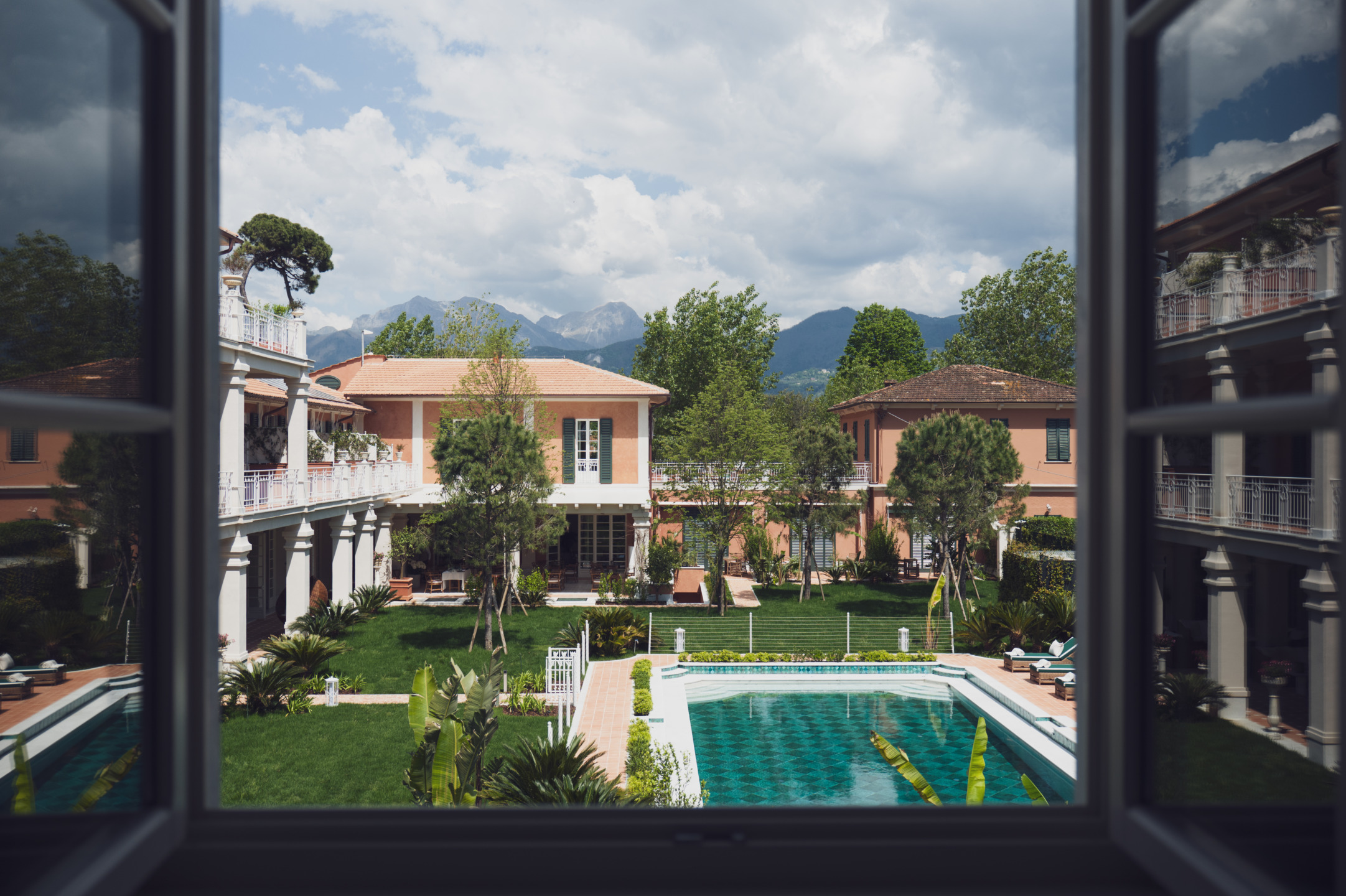Hotel of the Week: This Forte dei Marmi Gem Reopens After a Masterful Refresh
Collezione Em’s latest opening, Pensione America, captures the essence of when time moved more slowly on Italy’s Versilia Coast

Picture a small Tuscan beach town where the dramatic marbled Apuan Alps create an incredible backdrop to perfectly manicured beach clubs, where affluent Italians from Florence and Milan have been spending their summers for over a century. This is Forte dei Marmi. It’s the kind of place where Ferraris park next to vintage Vespas, Prada owns a cafe (the revamped Caffè Principe), Louis Vuitton has a designer gelato kiosk, and high fashion and simple pleasures just naturally coexist.
The saying “what’s old is new again” could be Sara Maestrelli’s motto. Creative director of Collezione Em—a Florentine family’s luxury hotel group that includes Grand Hotel Minerva in Florence, Villa Roma Imperiale in Forte dei Marmi, and Violino d’Oro in Venice—her latest project is the stunning Pensione America, which feels more like entering a family vacation home than a hotel. It’s one of Forte dei Marmi’s earliest villas and has been lovingly restored, opening as a Leading Hotels of the World member and adults-only boutique hotel.


The hotel got its start in 1899, when a Roman artist commissioned the building as his home. When he sold it around 1920, its new owners transformed it into a pensione, or boarding house, thanks to its grand size and ideal location. For decades, it operated as the kind of place where Italian families would spend entire summers, embodying that concept of villeggiatura—the Italian practice of lingering for long periods in beautiful places—that defined the resort’s early days.
“Pensione America is perhaps the most intimate expression of our family’s idea of hospitality,” says Maestrelli. “It’s a place rooted in memory, of summers that smelled like salt and linen, of long lunches under the pine trees, of a certain kind of Italian villeggiatura that’s hard to find today.”

With Collezione Em, the family carries a deep sense of place wherever they are, focusing on experience as the key factor in bringing a destination to life. “At Forte, that philosophy takes on a personal dimension,” she explains. “My family has been coming here for generations, and bringing Pensione America back to life felt like honoring a part of ourselves. It’s not about nostalgia for its own sake, but about capturing the simplicity and grace of a time when beauty didn’t need to be explained.”
Working with architect Piera Tempesti Benelli, Maestrelli started a restoration that honors the building’s history while making it comfortable for today. “Piera remembers a time when Forte was made of just a few villas tucked among pine trees, a short walk from the town center, with the gelato cart passing by in the late afternoon,” says Maestrelli. “These aren’t just nostalgic details; they’re the essence of what Forte dei Marmi once was, and what we wanted to quietly preserve.”

Benelli’s memories helped shape the design narrative of “simple, sun-washed spaces, linen and wood, and that feeling of openness and ease.” Tucked away on a quiet residential street just five minutes from the beach, Pensione America maintains an almost secretive presence—one could easily walk past without noticing the discreet entrance. But on the other side of the gate, a vine-covered pergola reveals the hotel’s peachy pink facade with its elegant shaded verandas. The pool nestles perfectly within the villa’s ambiance, surrounded by plush green loungers and an emerald lawn that feels more like a private estate than a hotel garden.
The hotel’s 18 suites and junior suites range from Grand Rooms designed for unassuming villeggiatura to signature suites for sumptuous retreats, with the crown jewel being the La Villetta—a standalone, two-story retreat nestled amidst pine trees and wisteria branches. Even the double suites are standouts, featuring private terraces overlooking the Mediterranean garden, where guests can enjoy morning espresso and breakfast al fresco in plush robes and slippers.


But it’s the artisan details by makers like ceramist Nicolò Giuliano that truly makes the hotel sing. “We stepped into his atelier in what felt like the middle of nowhere: palm trees, dust, maioliche, and ceramics stacked everywhere, and endless slices of cassata siciliana. We spent hours there, trying to identify the perfect shade of green.” Of course, in the months that followed, every box they opened contained a different green entirely. “It was nerve-racking at the time, but looking back, that unpredictability is exactly what makes it so beautiful now. That subtle diversity is part of the magic.”
Giuliano’s stunning tiles add character to the baths, where sundries from Santa Maria Novella—the legendary Florentine apothecary founded in 1221—conjure a spa-like sanctuary. A custom desk at check-in showcases the ceramist’s distinctive glazed terracotta work. Milan-born designer Elena Carozzi, whose grandfather was one of the founders of the Spatial movement with Lucio Fontana, creates evocative hand-painted wallpapers.
At Pensione America, Chef Sabrina Pucci, a Forte dei Marmi native (and somewhat of a town celebrity), leads the hotel’s kitchen with a homey approach that celebrates local traditions. Her menu features delicious pasta with arselle (baby clams), a particular specialty of the area, plus many fresh crudo dishes, and a popular fritto misto that’s perfectly crisp. Guests can also access the hotel’s fleet of bicycles, which provide an effortless glide along tree-lined streets to Bagno Assunta, the chic beach club perfect for lazing under vintage-looking cabanas and colorful umbrellas or enjoying perfect french fries, crisp salads, and fried seaside delights with afternoon Aperol spritzes.


So while the renovation opens a new chapter for the hotel, its essence remains untouched. “The same families return each summer, greeting each other with warm familiarity, their routines a testament to a shared history,” Maestrelli notes. “In Forte, change is embraced gently, ensuring that the spirit of villeggiatura continues to thrive for generations to come.”





